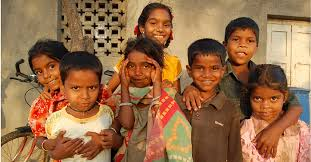India's Warped Idea Of The 'Demographic Dividend': Extracting From The Youth, But Not Investing In Them
India is all set to test the assumption that the youth bulge is a source of demographic dividend and an economic advantage. The assumption is that greater the number of people in an economy who work, save and pay taxes, higher will be the economic growth. With 356 million 10-24 year-olds, India has the world’s largest youth population in the world.
Three young girls seem to have tested the assumption with their
bodies. Their verdict is that all things remaining the same, demographic
dividend may be on life support.
A
fifteen year old government school student in Ganjam gave birth in her classroom. She bled in the bathroom, confused, she
ran back to her class, but before her class teacher could get help, she
delivered a child right there. The infant later died. The young girl went home
with her parents. She will now recuperate at the mercy of a quack or the rare
doctor at a Primary Health Care centre. Her child’s mind will grapple with the
machinations of the body, the death of her infant, the accusatory stares and
loud whispers and scathing judgements. Was she sent into the backyard to hide
the shame? Will she go ever back to school?
Jasmine, a class nine Ghaziabad student,
could have been marching to the tune of patriotic songs, had she not committed
suicide last month. Just rupees 12000 to furnish her school fees dues could
have saved her life. But her father, a security guard, didn’t have enough. Just
some empathy from her school and her teachers could have saved her life. But
instead her school teachers turned on her, donned the role of profiteers and
extortionists, arrived at her house and humiliated her father publicly. If only
she was a student of a government school providing free education, she would
still have been alive – but her father had aspirations – he wanted his three
daughters to get an English medium education, and was ready to make every
sacrifice.
Vaishali, a Class two student in Pune was
waiting for someone to do her a good turn. Her body was failing her. She needed
an expensive heart surgery. Her father, a small time painter was too poor to be
the provider. Vaishali beseeched the Prime Minister for help in a letter. Her
call for help made headlines, help arrived and her smiling countenance of
recovery made headlines and brought some political cheer as well. This story
left me wondering whether she couldn’t have reached out to a government
official closer home, maybe a District Collector, of Chief Medical officer. Is
begging for help the tried and tested method to access services - has the
language of rights escaped our national consciousness?
These
three girls do not know each other but would have understood each other. They belong to the group which has been gilded with a magic phrase
of economic growth – demographic dividend. The future of India, we are told,
rests on their fragile shoulders.
A short close
stare at the phrase ‘demographic dividend’ should allow us to deconstruct it,
and glean the extractive intent behind the phrase. While the concept of
dividend, in any other context cannot be seen separately from initial
investments, we make a comfortable exception when it comes to the young people
of India – as though irrespective of what and whether we invest in them, they
are either duty bound to produce dividends or are unthinking automatons who
will do so despite everything. Inherent in this phrase is a one way extractive
method of garnering returns, focussing on what young people can give to India
and not what India can give to her young.
Taking the
demographic dividend for granted will be the one most fatal mistake we can
make. Without increased investments in human capabilities, the future is likely
to be less than glorious. In addition, as the 2016
Human Development Report of UNDP warns, without fully unleashing the power
and potential of women, the demographic dividend will remain marginal at
best.
The young of
India will generate the dividend only when the country can invest in them – not
just by providing them skills to make them a cog in the wheel of a huge economy,
but by investing in their overall life skills and ability to deal with the
challenges of growing up in a complex and challenging environment. The
increasing absence of the factory led model of generating employment needs to
be acknowledged, and the impossible promise of jobs to young people needs to be
tempered lest the fall from grace be fatal. The demographic destiny of India is
at the mercy of institutions that deliver high quality education, universal and
affordable health care, nutrition and livelihood opportunities.

Comments